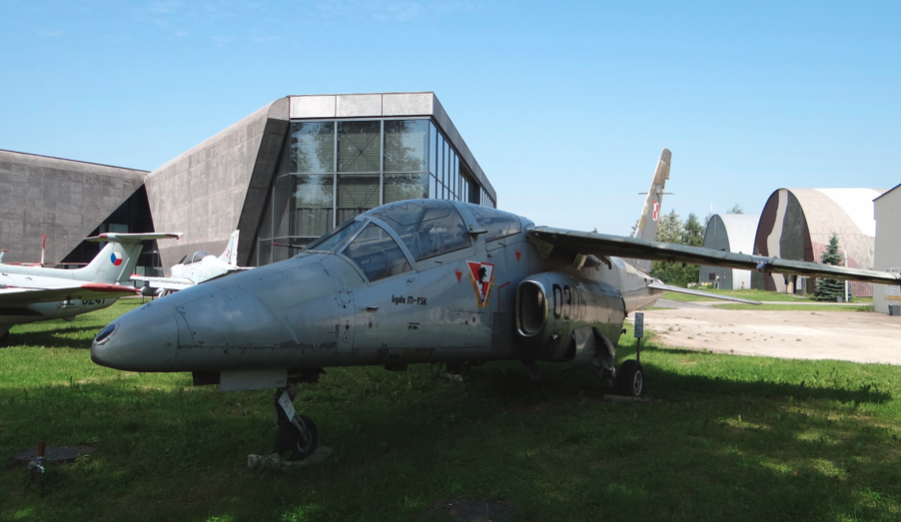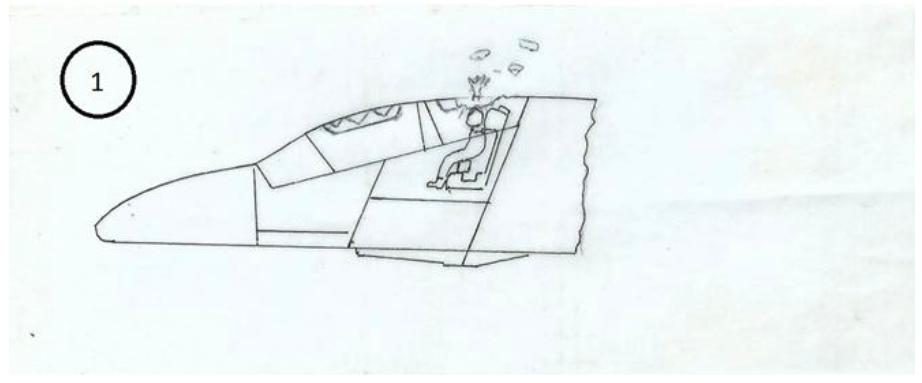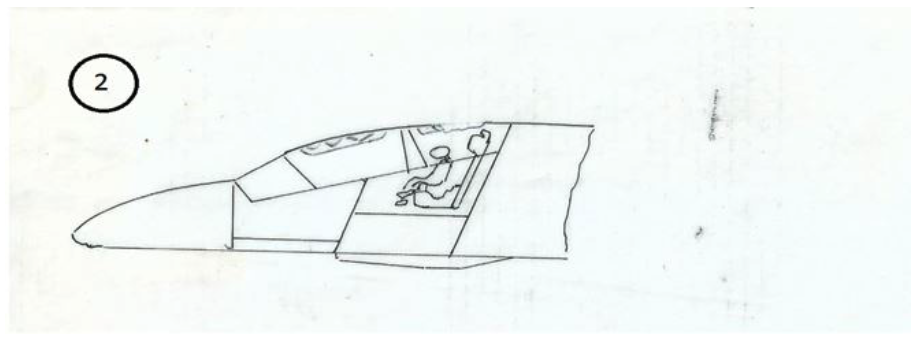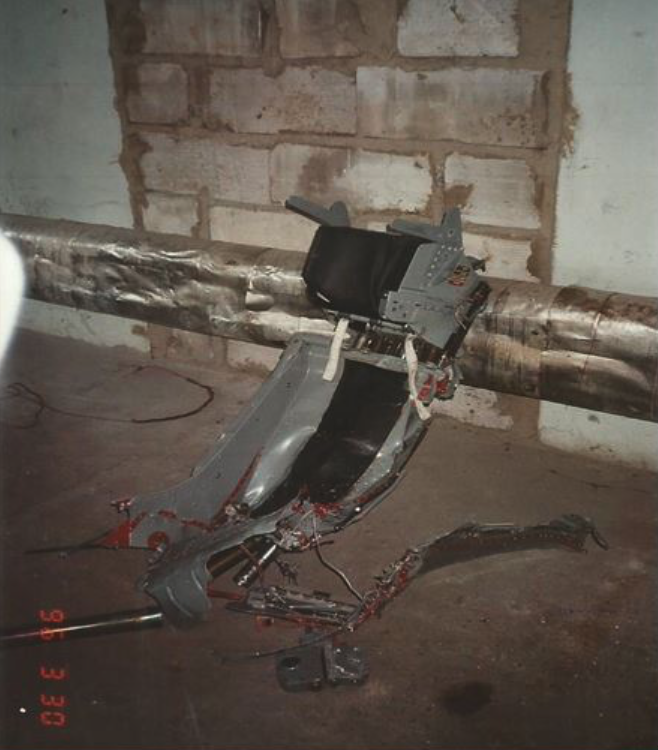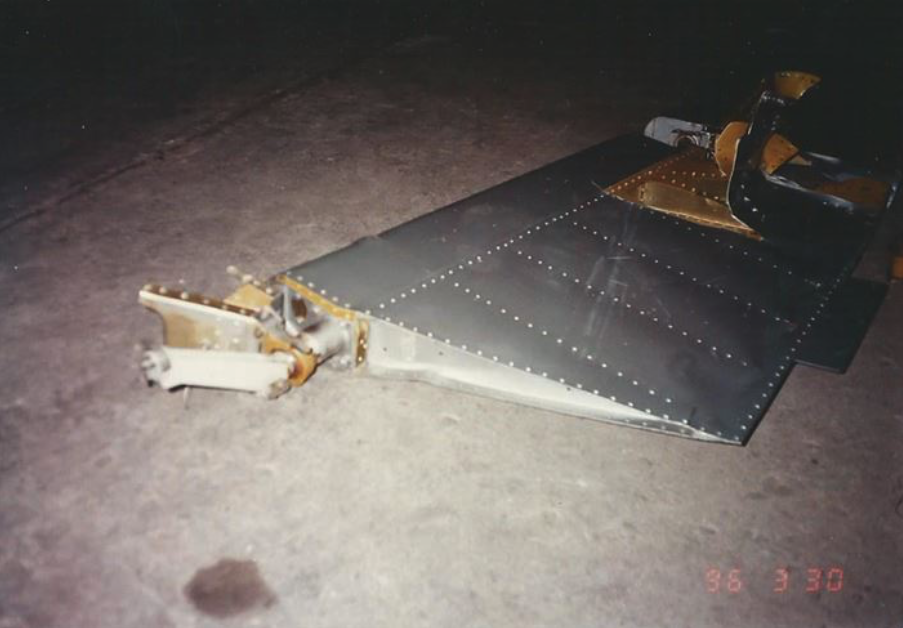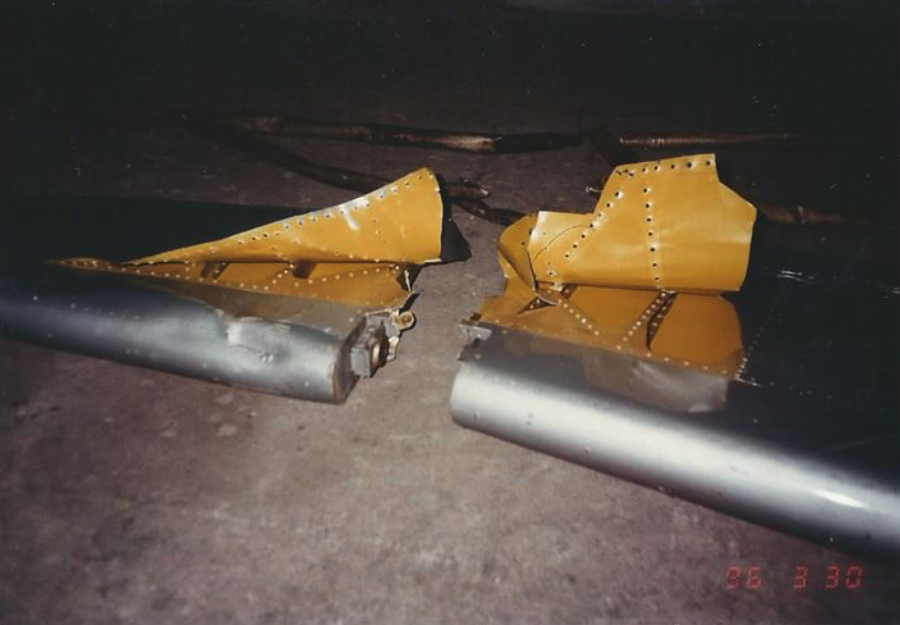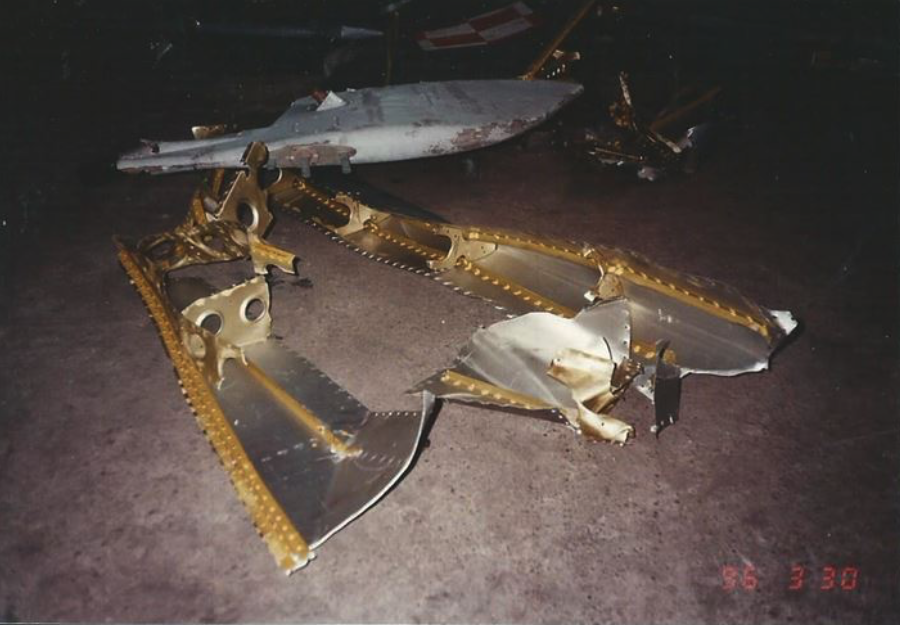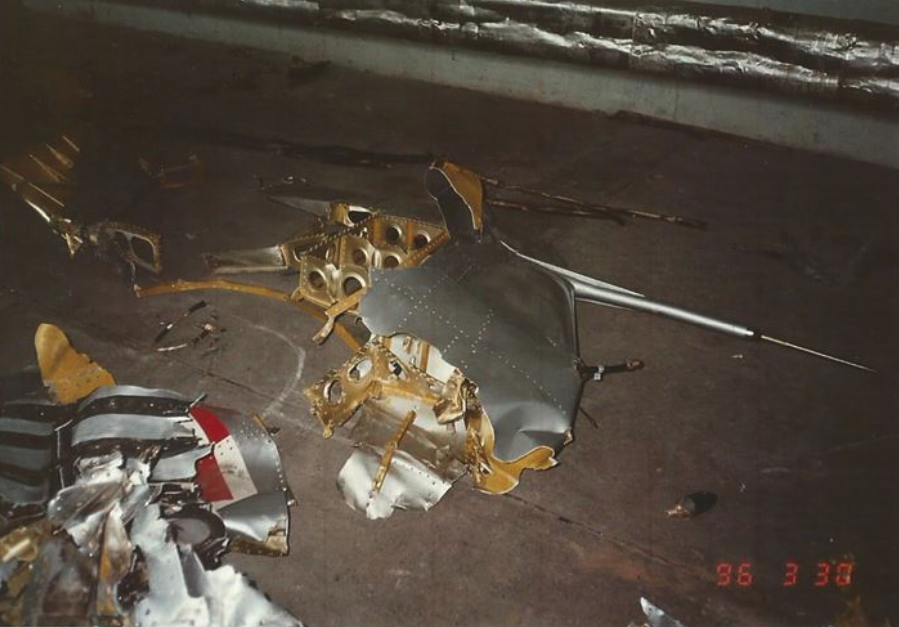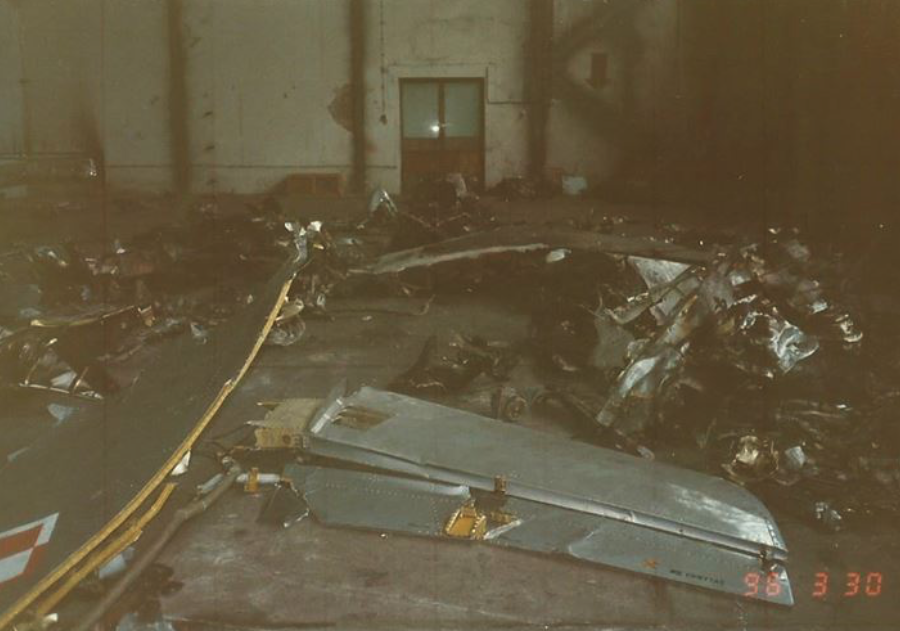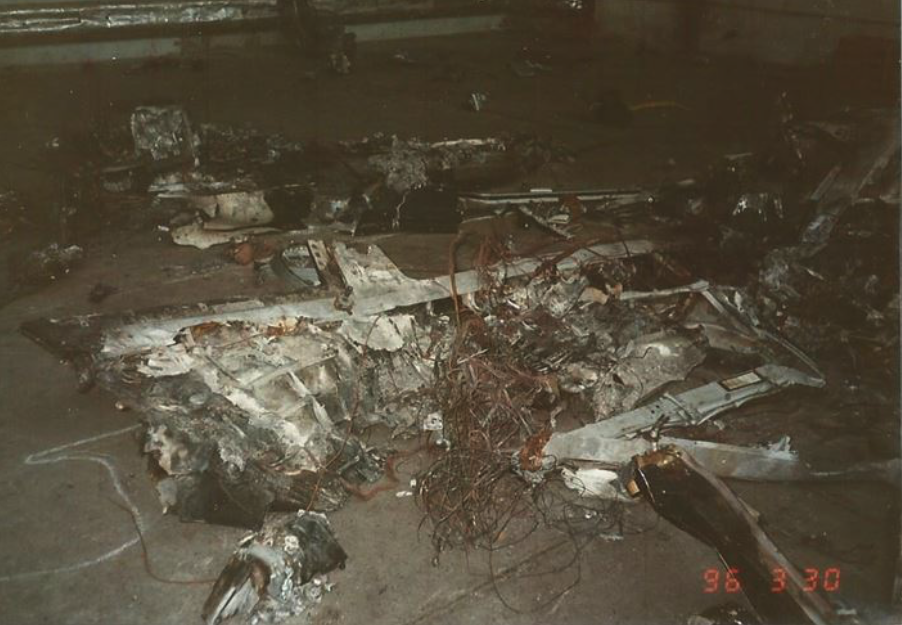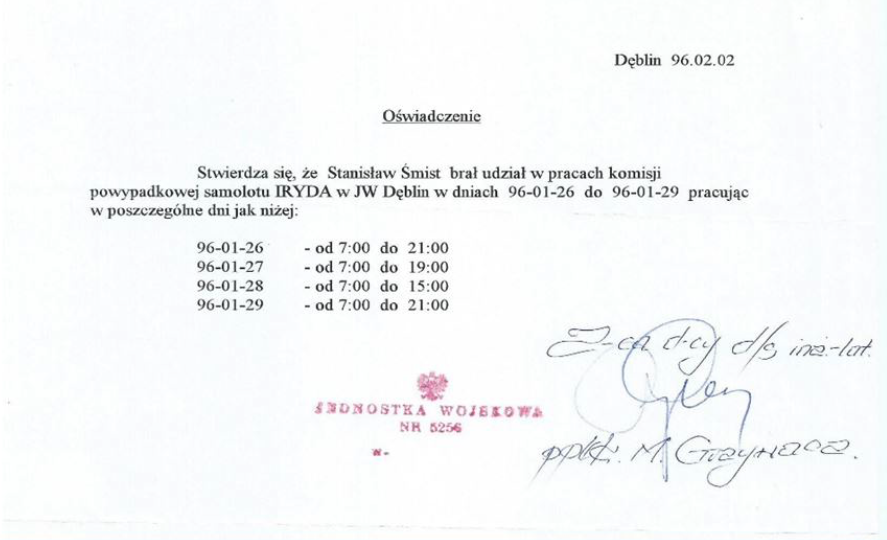Wrocław 2017-05-14
Teofil Lenartowicz
The tragedy of the Iryda plane through the eyes of the designer.
PZL I-22 Iryda no. ANA 02-03
January 24, 1996
21 years have passed since the Iryda accident, which began the destruction of the aviation industry. This topic will outrage public opinion for a long time, because what was done was incredibly stupid. Raising the topic of Iryd again encouraged me with the fact that one of the designers from Mielec, M.Eng. Stanisław Śmist sent me some of his memories and gave me permission to publish them. He participated in the Iryda Aircraft Accident Investigation Commission, where 2 pilots died in Dęblin in January 1996. When writing his memoirs, he described in detail the course of that Commission, which I would like to familiarize those interested with. Below is the full text of his memoirs, along with documents and photos:
The satisfaction with the use of Iryda aircraft at the Dęblin School of Eaglets was increasing and there were many praises. The next stages of modernization were hoped for, for example in the field of avionics. Avionics tests of a new manufacturer called SEXTANT have already been carried out in Mielec. According to experts, the avionics set was slightly worse than SAGEM’s, which was mainly characterized by development capabilities, but was much cheaper. Various arguments influenced the final choice of the avionics system. I have no evidence to provide, but I am sure that some anti-corruption institution would have a lot to say in this case. For many decision-makers, the most important thing was the money, the foreign delegation to the West, and even the dinner eaten in Paris, as I mentioned above, and not some Iryda. At the Ministry of National Defense and DWLiOP, Iryda was already becoming a hated plane, and the praise of direct users did not matter. These planes were not wanted there. However, the Navy aviation showed interest in the plane. The pilots of this formation once had the opportunity to fly this plane over the sea, when the plane equipped with SAGEM avionics was on a short courtesy visit to the airport in Babie Doły. One of the Navy pilots, when asked what he saw good in Iryda, answered simply: – This plane will always bring me home from a monotonous view of the sea, and moreover, I can always return home without drowning -. He further argued that when flying over the sea on a MiG-21, he could always expect an engine failure, because there is only one engine on this plane, and then there is no return to the airport and you have to land on the water. If you don’t kill yourself, which is a miracle, you will drown. Iryda has two engines and both will never fail at the same time, so you have a better chance of flying to an airport on land on one engine. It would be the only twin-engine aircraft in the Naval Aviation. The consequence of this willingness to use Iryda aircraft in Naval Aviation was the preparation and training of ground crew and pilots. The theoretical part of the training was conducted at the Aviation Plant in Mielec, while the practical part was carried out at the school in Dęblin. Several mechanics and several pilots were trained, who were already experienced pilots, but so far they had mainly flown MiG-21 aircraft.
On January 24, 1996, in the late afternoon hours, terrible news came to Mielec. The Iryda plane crashed near Dęblin. Two pilots died. Several designers from various specialties were assigned to go on a delegation to Dęblin the next day. Prepared for a few days’ stay, we took our places in Nysca and set off on our way to Dęblin.
At the same time, members of the management of the Aviation Plant went to Dęblin in passenger cars. We drove sad, even scared and lost in thought. We have tried to make various guesses as to the course and cause of the disaster, but so far we have received only scant information about the disaster. When we were close to Dęblin, the radio news reported the Iskra disaster near Dęblin. This news made us very depressed because we didn’t know whether we were going to the Iskra or Iryda disaster. Almost all of us had little to do with Iskra, which was operated by a separate service section in the Mielec design office. Only the engineer who was traveling with us knew Iskra. Mieciu Hyjek, who provided structural support to both Iskra and Iryda in terms of aircraft equipment, and mainly armament. However, we could not believe the radio news and return home, especially since we were already close to Dęblin. When we were passing a railway crossing and we were a few kilometers away from the Military Unit, the radio again announced the crash, but this time of Iryda, and a short interview with the Chairman of the Aircraft Accidents Investigation Committee, Colonel Urbański, who, among other things, stated that they were not at fault in this crash. People. Based on this information, it could be concluded that the cause of the disaster was obvious, because the Chairman of the Commission suggested and even stated the cause of the disaster before the Commission met as a whole. This information is a clear indication of blame on the plane. We arrive at the Unit, in front of the main building of the School Regiment. We are greeted in the hall by a sad Colonel Czyż. He addresses us with these words, among other things: – Gentlemen, a terrible thing has happened, Tomek Chudzik and Janek Mieszkowski have died, whatever you find while investigating this catastrophe, do not point to people, they are already dead, at least let their families have better compensation. The plane will be fine.
Although I had difficulty understanding these words, one thing caught my attention: compensation depends on who is to blame for the disaster. I don’t know if these matters are regulated by any regulations, I don’t know anything about these matters at all. In my thoughts and eyes I only had the pilots, especially Tomek, I got to know him better and we treated each other like friends. There were a lot of people milling around the hall, civilians and uniformed people. Some of them showed no sadness at all, and could even see ironic smiles. It’s already late in the evening and all the regular members of KBWL are already there. There are present and necessary representatives of the aircraft user and manufacturer who can be co-opted into the Commission. We all gather in a large conference room. The composition of the Commission is established, which includes active members with the right to vote during the deliberations and passive members without the right to vote, serving mainly to carry out all preparatory work and implement the recommendations of these active members. I am assigned to the passive members, like most of these ordinary builders, and given the task of “assembling” the plane from fragments and parts brought from the crash site, as the one who is most familiar with building the Iryda plane. I was assisted by a group of active-duty soldiers who extracted them from large piles of plane fragments, even collected together with the ground, presented them to me and placed them in the place I indicated, on the contour outline of Iryda drawn with chalk on the hangar floor in approximately life-size. Larger fragments were transported using hydraulic lifts. Such large fragments were the right side of the fuselage, almost long from the nose to the tail, although heavily scarred, as well as fragments of the wings and empennage. The left side and the remaining structure were in small pieces, as shown in the photos below. In these fragments I noticed many interesting phenomena that had no bearing on the cause of the disaster, but were astonishing from a technical, mechanical and physical point of view. Such an example may be a fragment of a longitudinal member permanently connected to a flattened tube of the control system. It can be described in more detail as follows: a fragment of the stringer, over half a meter long, detached from the aircraft’s skin, breaking off the rivet heads, and then this fragment of the stringer, bristling with rivet pins, collided with the pusher tube, approximately 30 mm in diameter, from the aircraft’s control system. in the longitudinal channel, the pipe was flattened, and the rivet pins punched holes in the pipe and attached a fragment of the angle bracket to the flattened pipe. Separating the two pieces revealed a series of holes cut into the pipe as if made by a die, but it was made by soft aluminum rivets in the aluminum alloy pipe. One can only imagine how enormous the dynamics of this collision must have been, or consider it an impossible phenomenon. There were many other fragments to consider. It was visible that some parts of the plane were engulfed in fire, which occurred, among others, in the cabin area, and the melted bodies of the manual controls, i.e. the mechanisms in which the control rod tubes are mounted, should be considered as evidence. Throughout the night, me and the group assigned to me worked on assembling the plane. We rummaged through the piles of parts and dirt that were piled up from the cars bringing them, finding smaller and smaller fragments and mechanisms and matching them to the place where they could have come from with the greatest possible probability. I don’t know whether the main part of the Commission also worked at night or went to sleep. I met this main part of the Commission during meals in the canteen. Right in the morning of the next day, I received an order to find the switch (AZS) that controls the hydraulic distributor feeding hydraulic fluid to the actuator that adjusts the height stabilizer. After finding this switch, members of the Commission took it to the meeting room for specialist examination, and from that moment on it was under special supervision. I was curious about the ejection seat from the second cabin. It was divided into at least two main parts. The seating part called the bowl was separated from the backrest along with the headrest and the pyro shotgun tube. This seating part was terribly abused, especially the sides of this bowl or, in other words, the armrests.
I wonder what could have damaged this part of the armchair so much? At first glance, colloquially, the bowl was moving across the cabin and bumping against the sides. It’s just an assumption. The ejection handle fitting was bent strangely, so that the handles were directed downwards instead of upwards. Correctly, these handles are located between the pilot’s thighs for ease of access. I guessed that the bend occurred when the bowl hit the ground. However, I changed my mind when someone brought an emergency container, on the surface of which I saw a clearly crushed shape of the ejection handle fitting. The dents, or rather embosses from the screws securing the fittings, were particularly matching. I tried on these two elements and wondered when the collision occurred. One of the members of this main part of the Commission, who was nearby, stated:
It bent when it fell to the ground -.
This is not true, the emergency container and the pilot’s body fell to the ground in a completely different place than the seat pan – I denied it.
I had, I already had information about where the bowl fell and where the pilot’s body fell. My clear opposition in this matter and in many other assumptions of the Commission resulted in the seat pan and the tray being confiscated from the hangar floor, and after the lunch break, Mr. Eng. approached the Director of the Aviation Plant. Piotr Rudny and ordered me to "close up" my mouth, under threat of immediate sending me home. I couldn’t even say "good morning" to the members of the Commission who appeared in the hangar for the first time. He forbade me from speaking, but he did not forbid me from drawing with chalk on the hangar floor. I tried to draw my thoughts, but I found no support from anyone. These military representatives of the Commission looked at these pictures and laughed ironically again. The ejection seat from the front cabin was not available at all. After four days of such work, my mission was completed and I went home. My participation in the work of the Commission is confirmed by the following declaration.
After a few days, the minutes of the final meeting of the KBWL chaired by Col. Urbański, still unofficial, were published, which stated that the cause of the disaster was the aircraft’s uncontrollability in the longitudinal channel, caused by the automatic deflection of the horizontal stabilizer plate upwards as much as possible, resulting from an electrical short circuit in the switch (AZS).
According to my own assessment, facts and assumptions, as well as based on the opinions of other witnesses of this disaster and their stories, the cause of the Iryda plane crash on January 24, 1996 was completely different. Based on these undeniable facts and presumptions, it describes the possible course of events that had any connection with this disaster. Not all sequences in this description may be actual, but they may be possible. As I mentioned earlier, the causes of a plane crash, but not only them, can never be determined with 100% certainty and I always accept this rule. In most cases, perhaps even in every case, the cause of a disaster is not one single event, but a series of events that increase the likelihood of a disaster occurring. Such sequences of events occur constantly, but it is enough that such a sequence is interrupted and a disaster does not occur. We are not even aware of these facts. I warn readers that the further description may contain drastic scenes, so I recommend skipping these parts of the description.
The course of this disaster began the day before, before the actual day of its event. The practical training of Naval Aviation pilots was scheduled to end on this day. The training was carried out in two-person teams consisting of an instructor pilot from the Dęblin school and a student pilot from Naval Aviation. Such a team consisted of, among others, student pilot Capt. Jan Mieszkowski and an instructor pilot unknown to me. This team used an aircraft with factory number AN002-03 for training. Unfortunately, there was a slight delay in training in this team due to the temporary indisposition of the student pilot. The remaining teams completed the entire training cycle, but this duo still had to perform a higher aerobatics flight. It was decided that this flight would be performed after the official end of training. The end of such training was, as usual, an excuse to organize a celebration or an event where, among other things, alcohol was served. Of course, as I have described such cases before, those who had flights scheduled the next day could only smell the smell of alcohol or use it in a symbolic amount. This included pilot Mieszkowski and his instructor. However, the instructor did not follow this rule and was not available to fly on the next day. He informed about his indisposition by phone and asked for leave from work. Major Tomasz Chudzik was available as a substitute instructor for this flight, and he had not abused or even used alcohol on the previous day, probably for the reason I had already mentioned. The plane on which the student pilot had been training was ready to fly. The seat in the first cabin was taken by the student pilot, Capt. Jan Mieszkowski, and in the second cabin, the instructor pilot, Major Tomasz Chudzik, sat down. The physique or posture of the Chudzik pilot was completely different from that of the instructor pilot who had previously sat in the cockpit. He was of stocky build and not very tall, while Tomasz Chudzik had a slim, athletic figure and was quite tall. With such a difference in posture of pilots sitting in the same seat, the position of the seat pan and the length of the belts holding the pilot in the seat should be adjusted. However, the instructor pilot did not do this and this was the first major contribution to the subsequent disaster. After closing the dome, the mechanic serving the pilot in the second cabin suggested lowering the seat pan, but the pilot squeezed his gloved hand between the dome glass and the headphone and decided not to lower it. This operation can only be performed when the aircraft is stationary.
Here I will quote a fragment from the description of the construction of the Iryda plane, which boasted that the cabins were vertically offset from each other, which improves the forward visibility of the pilot from the second cabin and his view is not obstructed by the elements in the first cabin, moreover, the position of the seat is vertically adjustable and can be adjusted depending on the pilot’s height. The engines were started and the plane took off from above the runway. According to previous arrangements, first the instructor pilot was to show the student pilot how to control the so-called figures. higher aerobatics, and then the student pilot had to repeat it. In the charts from the SARPP recorder, you can clearly see at what point the student pilot took over the control. His habit of controlling the MiG-21 plane, which he mainly flew so far, can be seen when controlling Iryda. The control movements are dynamic and full, as required by the MiG-21, while Iryda required delicate and fluid movements and was controlled by Tomasz Chudzik, a pilot with extensive experience in this aircraft. Some pilots flying Irydas claimed that Iryda really "listen" to the pilot and follow his even subtle movements with the control stick, while others were more vulgar in their words that Iryda behaves like a distraught… like a girl on the sidewalk. When the student pilot took over the control and performed the first figures, the instructor pilot noticed that he was not fastened enough to the seat by the belts and was moving around the seat. Why didn’t he notice this while he was controlling the plane? I will try to explain it based on human physiology, although I have never had anything to do with this field of science. It seems to me that the human brain, which sends "orders" to the muscles that move, for example, the aircraft’s control system, simultaneously sends orders that block the appropriate muscles to counteract the inertial forces expected in a given movement situation. I noticed this phenomenon while driving a car, in more or less the same conditions, as a driver and then as a passenger. I think this phenomenon occurred in this case.
Returning to the course of the disaster, the sequence of events could have been interrupted at this point if the instructor pilot had informed the student pilot controlling the plane at that time to maintain the plane’s flight path without overloads for a moment, giving the opportunity to adjust the seat belts. However, the instructor pilot did not do this. When the plane leveled out, he decided to lift the white lever located next to the left armrest of the seat and move it forward, which should cause the seat belts to automatically tighten. By coincidence, however, at the same moment the student pilot controlling the plane put the plane into a dive, causing significant negative overload. The forces acting during this overload, among others, on the instructor pilot’s body, moved him upwards, even more freely since the seat belt blockade was released. The pilot, wearing a headphone, hit the glass of the dome and knocked it out, breaking the electric circuit of the detonation cord from the pyro-crushing circuit of the glass, and probably breaking the vertebrae in his cervical spine. I’m saying that it probably happened at that moment because the pilot had such damage, although it doesn’t take that much force to break the dome glass from the inside and sometimes the cabin pressure helps. Such a case has already happened to a factory pilot from Mielec, who landed at the airport with a large "hole" in the dome glass, but without any damage to his health. He claimed that it was a bird or something else that hit the glass and damaged it, not admitting to the loose seat belts and marks on the headphone. In this case, the forces from the negative G-force also acted on the seat emergency reservoir, which, behind the pilot’s legs, slid out of the recess in the seat cushion. At this point, at least three elements separated from the plane: fragments of broken glass, a fragment of the so-called the headphone visor, i.e. a transparent, movable cover for the pilot’s eyes and face, and the pilot’s right glove, pulled off his hand by air streams, thrown outside the cabin by the force of g-force. This hand was free at that time, and the other one was occupied with the belt tightening lever. These three elements were found close to each other, at the furthest distance from the plane’s impact with the ground.
After a momentary effect of negative overload, the order of things is for the overload to return to zero or even change direction to positive. In this case it was an overload with a large positive value. The forces acting on the instructor pilot put him back in the seat, but unfortunately the emergency container did not fit into its place. The container box moved slightly forward and hit the fitting of the ejection handles. By pressing on this fitting with its own weight and the pilot’s body weight, the box caused the fitting to bend downwards and the ejection handles were directed towards the cabin floor. The shapes of the fittings and the screws securing them are reproduced on the container box. This bend in the fitting triggered a cycle of ejection of the seat, which was not wanted by the pilot. During this cycle, sequential actions of individual systems in the entire catapulting system take place in a very short time. These time intervals are so short that it is even difficult to determine which actions come first and which come next. The glass pyrocrushing system was probably activated first, but this action was not carried out because the circuit of the cord with the detonation charge placed on the glass had previously been interrupted. The system of pulling the pilot’s legs to the seat worked, protecting these body parts from damage when the seat and the pilot left the aircraft cabin. A charge was fired in a pyro shotgun, and the accumulated energy of the explosion of this charge should have lifted the seat together with the pilot to a height of approximately 1,600 millimeters from the cabin floor. At the same time, a rope is woven from the labyrinth located on the body of the rocket engines, located under the seat of the chair, with one end attached to the cabin floor and the other to the trigger that fires the rocket engines. However, the line did not weave out completely. There are about 120 millimeters of line left in this maze. The seat together with the pilot stops in the upper part of the guides attached to the inclined 19th frame of the fuselage. The seat should move along these guides until it leaves the plane. Further movement of the chair should be ensured by the running rocket engines. In this case, the chair stopped and the rocket engines did not fire.
Why did this happen? There is no clear answer to this question in my description of the course of the disaster. There may be various guesses, including: the charge in the pyro shotgun was too weak and did not raise the seat to the required height, this would be a mistake of the seat manufacturer; the launch of the pyro-shotgun took place at a positive overload greater than 2.5 g, and therefore above the overload that is permissible for the VS-1BRI seat, at which the manufacturer of the seat guarantees that the chair will be thrown to an appropriate distance, this could have happened, after all, the catapulting actuation occurred at the moment of positive impact overload. Unfortunately, I do not have proof of this, because firstly, I did not have free access to the flight data recorder records, and secondly, the moment of launching the catapulting is not recorded on the recorder tape.
Why is there no recording on the recorder tape of the moment of catapulting? In my opinion, the answer is simple, although it requires a broader explanation. There is no record because in my opinion the Iryda plane had a serious design error at this point. Well, the so-called signal was fed to the recorder. zero-one, coming from the disconnection of the ARK connector, and this disconnection occurred after the seat left the plane. Another question could be asked here: Why and who needs such information to be recorded on the recorder? Probably just to capture the time or moment when the seat left the plane. The actual throwing of the seat is always possible to visually detect after the fact, because either the seat and the pilot will remain with the plane or will be in a different place. What would be interesting for a crash investigator would be information about the moment the catapult was launched, or even the pilot’s willingness to use the ejection seat, confirmed by pulling the ejection handles. However, there was no such possibility on Iryda and this was the mistake that I have repeatedly accused the designers of this system. Similarly, it was impossible to send this signal to the recorder, because the SARRPP recorder required the signal to last for at least half a second to be recorded. Before introducing appropriate design changes, these were the arguments used by the designers of the ejection system.
Yet another reason for not throwing the seat to the appropriate height could have been the consumption of energy to overcome some accidental braking force. Such a force could have been the ejection handle catching on some element in the aircraft cabin. Catapulting handles are two separate handles attached to Y-shaped forked cables. One of these lines was broken. When and under what circumstances was this line severed? I carefully inspected this link. It wasn’t a bare cable, but a plastic sheath, or rather encased in plastic. On this plastic, in the place of the break, I noticed traces, as if from the threaded screw on which this one handle was caught. Some time after the disaster, I looked through the cabins of many Iryda aircraft, looking for an element that could hook the ejection handle and slow down the seat ejection. I didn’t find anything like that, although while examining parts of the plane after the crash, I found that on the manual control body, where the tiller tube is attached, there is a screw that is longer than the one provided for in the construction documentation. Such a screw, which was several millimeters longer, was mounted only on the body of one tiller, and such identical bodies are available in the front and rear cabins. However, I was not able to determine from which cabin the body had this longer screw. Both bodies were heavily melted. Could this screw have stopped the chair? In such a case, the jerk of the hand control movements should be recorded on the recorder. Unfortunately, I never saw these records.
Let’s go back to the description of what happened on the plane. The pilot and his seat were partially exposed outside the plane’s outline to the destructive effects of air streams that tore the skin on his face, eyelids and cheeks. His face was not covered because the headphone cover had been torn off and had already fallen to the ground. The student pilot probably saw this image in the rear-view mirrors located on the periphery of the front dome. The next steps in the ejection cycle took place, i.e. the release of the seat parachute. The open canopy of this parachute introduced a significant force into the aircraft’s balance system, causing the aircraft’s nose to nose up and a drastic reduction in speed to which the pilot reacted. He increased the engine power to maximum values and also consciously took advantage of moving the horizontal stabilizer plate upwards as much as possible, increasing the angle to friction and aerodynamic forces that tilted the plane. With this adjustment, he wanted to help himself align his flight with horizontal motion.
I emphasize that this action was performed consciously by the pilot and not, as the Commission stated, that the ballast was adjusted automatically due to an electrical short circuit of the switch. However, these actions performed by the pilot did not allow the plane to level out and maintain sufficient speed. To increase speed, the pilot tilted the plane into backward flight. In this configuration, the aircraft quickly gained significant speed, which increased the seat-pulling force coming from the open parachute canopy. This force was so great that it broke the seat backrest and the pyro-gun tube, which separated from the plane. These elements hit the aircraft’s tail and significantly damaged the horizontal and vertical stabilizers. The pyro-gun tube extending from the plane damaged the pilot’s body, which was tied with leg straps to the seat pan stuck against the sides of the fuselage, and also caused the pilot’s rescue parachute to deploy. Only for a moment did the force from the seat parachute disappear from the forces acting on the plane.
Now there was an even greater force, with a similar effect, coming from the partially open canopy of the rescue parachute. This parachute opened only partially because the canopy became entangled with the protruding elements of the damaged tail. The force from this canopy pulls the pilot’s body, which is still strapped to the seat pan. Aircraft maneuvers that flip the plane from normal flight to backward flight to increase speed also increase the pulling force on the pilot’s body. The tendons are severed and the pilot’s feet are pulled out of the shoes that were attached to the bowl. The pilot’s body, attached to a parachute harness and whose canopy is tangled in the empennage, is dragged behind the plane.
At this point, the aircraft’s flight parameters are already destructive for the aircraft, especially for the damaged tail. The horizontal tail cannot withstand these loads and detaches from the hull. The overload that appeared in the aircraft’s cabins at that moment breaks out the jammed seat pan, which falls out of the aircraft and disconnects the ARK connector, and only then is the ejection signal sent to the SARPP recorder. This is the last signal recorded on the recorder, because at the same moment the vertical stabilizer in which the recorder is located detaches from the fuselage.
The further movement of the plane can no longer be called a flight. During this indeterminate movement, the left wing tip breaks off and the remaining part of the plane hits the ground. The impact is so strong that the ejection cycle of the first cabin seat is initiated. The student pilot and his seat are thrown away from the plane, but at too flat an angle and at zero speed, and yet it is a 0-150 class seat, which means that for a guaranteed opening of the rescue parachute, an object’s movement speed of at least 150 km/h is required, so the rescue parachute it did not open because the altitude was too low and the speed of the object from which the catapulting occurred was zero. The pilot did not even have time to separate from the ejection seat. The seat and the pilot fell to the ground. I use the word pilot here, but it was probably a pilot’s body. A person should not have survived the overload that probably occurred after the tail separated from the plane. The remains of the plane were engulfed in fire. I present the course of this catastrophe graphically in the handwritten sketches below.
After such a description of the disaster, the reader will probably have many questions in his mind. When trying to explain the causes of a disaster, there are always more questions than there are answers to those questions. If all questions could be answered, the causes of all disasters would be explained one hundred percent, but this is never the case. I could answer some questions about this catastrophe or at least guess what the answer might be. For example, the question that someone to whom I was telling about this disaster asked me with interest was as follows: Why didn’t the pilot in the first cabin, seeing what was happening, save his life by ejecting? My answer may be twofold. One results from the analysis of my behavior, i.e. how I would behave if I were in the position of the student pilot. Would I dare to pull the catapult handles, seeing in the mirrors what was happening in the second cabin? After all, I’m sitting in the same seat, and the plane can still be controlled. I don’t know why the seat from the second cabin didn’t come out. I wouldn’t dare. Did the student pilot make the same analysis? The second answer is simpler, although it is also conjectural. The student pilot pulled the catapult handles, but the catapult was not initiated. Unfortunately, due to the design error I have already mentioned, this desire to catapult was not registered on SARPP. The catapulting was not initiated because the catapulting synchronization system was activated, i.e. until the seat from the second cabin has left the plane, the catapulting in the first cabin cannot be started, and yet the signal about the seat leaving the plane is again taken from the disconnection of the ARK connector. You can ignore the synchronization system with a special switch, but you need to know about it. I base my suspicion of lack of knowledge about this possibility on the statement that many pilots who flew Iryda did not read the pilot manual or forgot some information, which I found when conducting an exam on cabin equipment for almost half of the pilots flying Iryda. Only a few pilots knew about this switch, possibly because the synchronization system was introduced by bulletin at a later date.
It was similar with AZS, which was additionally introduced into the landing gear extension circuit, after a fault reported by pilot Henryk Bronowicki regarding the inability to extend the landing gear, which I described earlier. After the research was completed by the Military Commission for Aircraft Accidents Investigation, supplemented by specialists from the Institute of Aviation, the Aviation Plant in Mielec, the Military Unit in Dęblin and many other institutions, I also had many questions that no one tried to answer. These main questions included:
Why didn’t KBWL deal with the ejection seat and explain the circumstances of the initiation of the ejection and the damage to the seat?
Why were the seat parts, after my suggestions, confiscated by the Commission and disappeared from the field of inspection?Why were so many specialists from the Institute of Aviation, the Aviation Plant and other institutions convinced of the groundless ruling of the KBWL?
Many did not accept this ruling and tried to deny the protocol of this Commission. However, these actions were to no avail. The Commission’s protocol was created according to the recommendations of the Ministry of National Defense and DWLiOP, which ultimately wanted to end the Iryda program and such an opportunity arose.
Some time after the disaster, when flights on Irydy were resumed, 1st class test pilot M. Eng. Ludwik Natkaniec, who was a very inquisitive person, surrounded by engineers who did not believe in the provisions of the post-accident protocol, made the following attempt: While flying one of the prototypes of the Iryda aircraft, he moved the horizontal stabilizer plate to the maximum upper position, as it was done during the disaster and proved that the plane can be controlled in this configuration. It is true that the forces measured on the tension-metered control stick reached up to 70 kg, but this could be overcome with the strength of the hands, and it could have been achieved even more by the two pilots who sat in the plane during the unfortunate flight, assuming, of course, the Commission’s instructions that in this configuration the plane could not be flown. control. Moreover, Ludwik Natkaniec landed in such a configuration, which was certainly too great a risk and an exaggeration of his own piloting skills. But that’s how Ludwik was, he always had to do a little more than he was allowed to do.
I will tell you one more story about this disaster. Well, a few years later I met a man who was probably an eyewitness to part of this disaster and he told me about such an event. He was a man of little intelligence, living in the countryside near my sister. I often met him during neighborhood agricultural work, where I also helped my sister on the farm. He worked at WSK Mielec in a warehouse and on a railway ramp with metallurgical materials. He wasn’t really interested in aviation. However, on the day when he was leaving the factory forever, I met him on one of the factory sidewalks, looking for some offices to sign the circulation card. Then he turned to me with the following request: – Staszek, would you show me the plane up close? I have been working at this factory for so many years and I have never seen an airplane up close, I was never interested in it, and today is my last day at the factory. – This is more or less what his request should have sounded like, because it was my choice of words that meant something from his flow. slurred speech interspersed with swear words. I took him to hall 2, where some old An-2 planes were being renovated. He looked at the plane with interest and even touched it. He was pleased and grateful to me for this show. We didn’t see each other for the next few years because he left these areas after a family tragedy and moved to other parts of Poland. After this long period, I just accidentally met him while visiting my old place of residence and in conversation he informed me that he now lives in Niedźwiedź. I associated this place with the Iryda disaster and said:
So now you live where the Iryda disaster happened a few years ago? – I asked.
After a moment of thought, he replied: – You know, Stachu, I remember this day. -I didn’t expect this, so I quickly started to continue this topic, asking him to remember everything carefully and tell me. – It was winter then. In the alder forest growing near the house, I cut down several trees to make battens and pickets for the renovation of the fence and brought them home. There are still branches in the forest that I went to pick up that day. The horse and cart were standing near the forest, and I was stretching out branches. Suddenly I heard the terrible roar of the plane. I looked at the sky. You could barely see anything because it was a bit foggy and the sun was barely shining through. I noticed that a plane was flying fast and was dragging a flag with a package behind it. At the same time, the flag fell off and fell to the ground along with the mirror.
What about this plane? – I asked quickly.
The plane hid behind a tree and I just heard something go… I flew out of the forest and saw a pile of black smoke coming from the trees that were too far away. I jumped on the cart and whipped the horse. I left the car in the yard and got on my bike. I was driving towards where I saw the smoke. When I got to the area, the fire brigade was extinguishing the fire and the police and firefighters did not allow me to get closer. By then there was little smoke.
This is where my friend’s story ended. In several places, my friend’s story needs to be interpreted, because it was a simple description of the phenomena he saw. The flag he saw was, of course, the white and orange canopy of the pilot’s rescue parachute, and the mirror was the vertical stabilizer shining in the sun, which had detached from the fuselage along with the parachute and the pilot’s body, which, according to his observations, could have been a package.
According to information obtained from the Chief Designer, Eng. Włodek Gnarowski, at the Institute of Aviation, an analysis was carried out of parts and elements found in the space around the place where the plane crashed, which fell off the plane before it hit the ground. It was done more or less like this: circles of various radii were drawn on a map of the surrounding area with the center in the place where the plane fell and the places where any parts of the plane were found were marked. Although it cannot be confirmed that the plane was moving in a straight line from the moment of the disaster’s initiation, one can determine which elements of the plane fell off the earliest. As I mentioned earlier, the furthest elements were fragments of glass, fragments of the helmet visor and the pilot’s glove. Closer to the center of the circles was the backrest of the ejection seat with a headrest and a stabilizing parachute, and even closer were fragments of the horizontal stabilizer. The vertical stabilizer and the body of the instructor pilot with a parachute were found almost at the same distance. The tip of the plane’s left wing was closest to where the plane fell. The distribution of these elements agrees with the assumption of the order of destruction of the aircraft presented above. The above-mentioned facts and the logic of the presumptions almost completely convince me that the cause of this disaster was the pilot’s error in not tightening the seat harness belts before the flight.
Stanisław Śmist
The above text is a clear example of the enormous damage that irresponsible dissidents at higher levels of government are causing to Poland without taking any responsibility. Iryda could have been the goose laying golden eggs, because India, other contractors and naval aviation were already waiting. Opinions about this plane were known to many domestic and foreign specialists, because its performance was equal to planes of this class, and in some respects it exceeded them.
Teofil Lenartowicz
Wrocław, on May 15, 2017.

